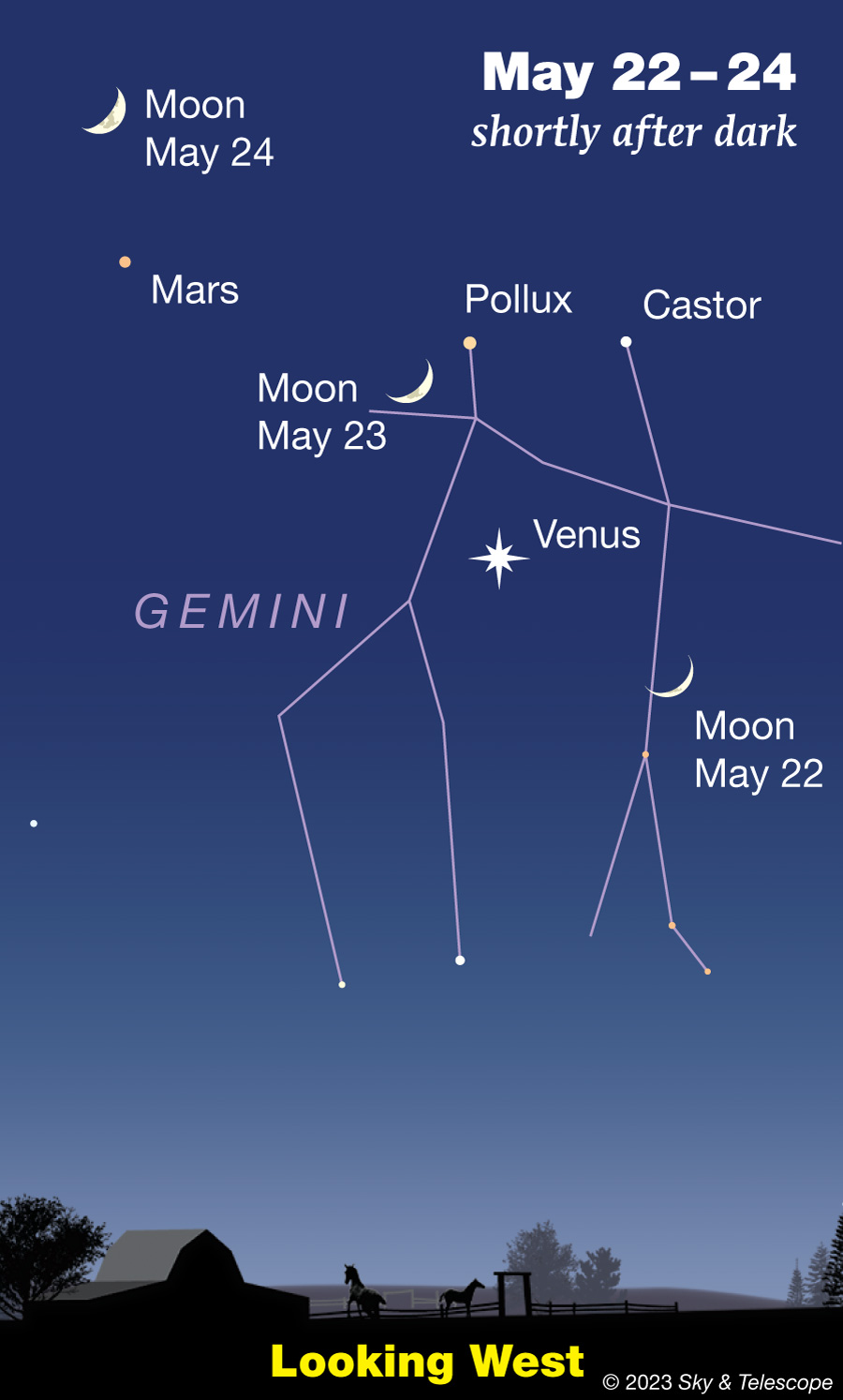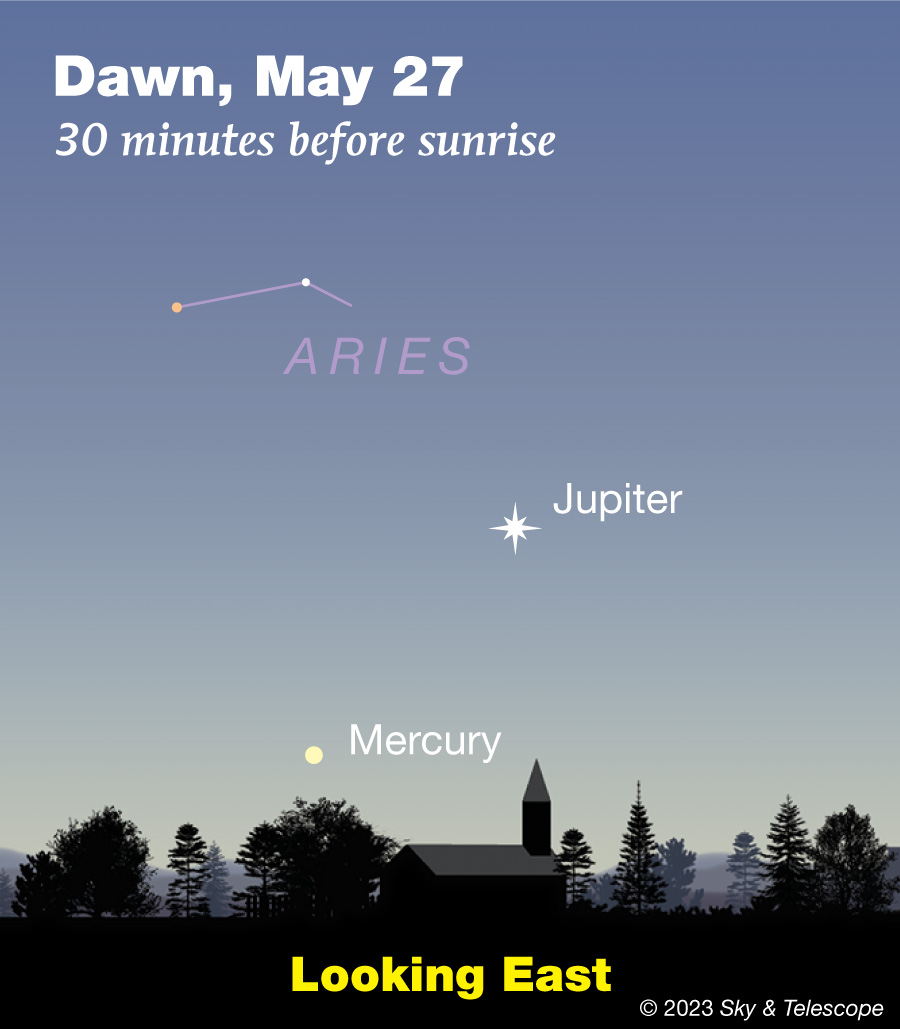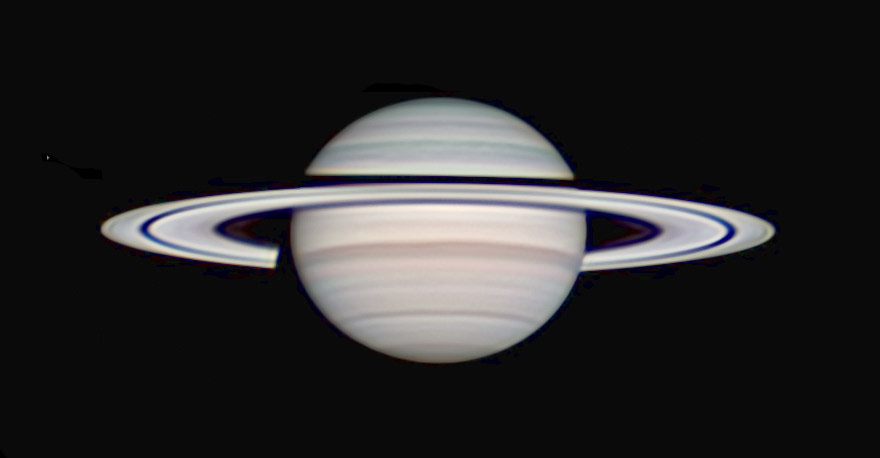FRIDAY, MAY 19
■ With spring advancing, bright Vega is nicely up in the east-northeast after darkness is complete. Look for its faint little constellation Lyra hanging down from it, with its bottom canted to the right. Lyra's stars form a little equilateral triangle (Vega is one corner) and a parallelogram that hangs from the triangle's bottom.
■ New Moon (exact at 11:53 a.m. EDT).
SATURDAY, MAY 20
■ With summer still a month away (astronomically speaking), the last star of the Summer Triangle doesn't rise above the eastern horizon until about 10 or 11 p.m. That's Altair, the Triangle's lower right corner. Watch for Altair to clear the horizon three or four fists at arm's length to Vega's lower right.
The third star of the Triangle is Deneb, less far to Vega's lower left.
SUNDAY, MAY 21
■ This is the time of year when Leo the Lion starts walking downward toward the west right after dark, on his way to departing into the sunset in early summer. After nightfall, spot the brightest star fairly high in the west-southwest. That's Regulus, his forefoot.
Regulus is also the bottom of the Sickle of Leo: a backward question mark about a fist and a half tall that outlines the lion's leading foot, chest, and mane.
MONDAY, MAY 22
■ The waxing crescent Moon shines lower right of Venus this evening, as shown below. The widening trio of Mars, Pollux, and Castor floats above them.

TUESDAY, MAY 23
■ In the 24 hours since last evening, the Moon has moved along its orbit to shine upper left of Venus — as seen from North America. Halfway between these evenings the Moon passed just a couple degrees from Venus, when the scene was on twilight display for the longitudes from easternmost Europe to Central and South Asia.
WEDNESDAY, MAY 24
■ Spot Mars a little below the Moon this evening, as shown above. Mars is actually twice the diameter of the Moon, but it's currently 730 times farther away.
■ What is the oldest thing you have ever seen? For everyone in the world it's at least the Sun and other objects of the solar system, age 4.6 billion years. Most everything on or near Earth's surface is much younger.
Next is Arcturus, which most people have surely seen whether they know it or not, since it's one of the brightest stars in the sky. It's a Population II orange giant, age about 7 billion years, just passing through our region of the Milky Way. There it is, very high toward the southeast or south these evenings.
Amateur astronomers have globular clusters. Most are older still, at least in part. The familiar M4 in Scorpius has been dated at 12.7 ±0.7 billion years by means of white dwarfs within it.
But individual stars that you can observe? For that you want Bob King's article In Search of Ancient Suns with its finder charts. Assigning dates to individual stars that have been around since the first eras after the Big Bang is still iffy; astronomers have to work from the near-absence of heavy elements in their spectra. But a 6th-magnitude star in Bootes and a 7th-magnitude star in Libra, both in binocular range, await you these May and June nights. They probably date from about 12½ billion and at least 13 billion years ago, respectively. These will probably be the oldest things you have ever seen, or ever will. The Big Bang itself is well dated at 13.8 billion years.
One could pick nits. Pick a proton, any proton right in front of you, and it has very likely remained intact since forming in the Big Bang's first millionth of a second. And what a variegated history it has seen!
THURSDAY, MAY 25
■ Vega is the brightest star in the east-northeast after dark. Look 14° (about a fist and a half at arm's length) to Vega's upper left for Eltanin, the 2nd-magnitude nose of Draco the Dragon. Closer above and upper left of Eltanin are the three fainter stars forming the rest of Draco's stick-figure head, also called the Lozenge. Draco always points his nose to Vega.
The faintest star of Draco's head, opposite Eltanin, is Nu Draconis. It's a fine, equal-brightness double star for binoculars (separation 61 arcseconds, both magnitude 4.9). The pair is 99 light-years away. Both are hot, chemically peculiar type-Am stars somewhat larger, hotter, and more massive than the Sun.
FRIDAY, MAY 26
■ The Moon, very nearly first quarter, shines in the Sickle of Leo after dusk. It's almost between the Sickle's two brightest stars: Regulus, lower left of the Moon, and fainter Gamma Leonis or Algieba, to the Moon's upper right.
■ Have you ever seen Alpha Centauri? At declination –61° our brilliant, magnitude-zero neighbor is permanently out of sight if you're north of latitude 29°. But if you're at the latitude of San Antonio, Orlando, or points south, Alpha Cen skims just above your true southern horizon for a little while late these evenings.
When does this happen? Just about when Alpha Librae, the lower-right of Libra's two brightest stars, is due south over your landscape. At that time, drop your gaze straight down from there.
SATURDAY, MAY 27
■ First-quarter Moon (exact at 11:22 a.m. on this date EDT). This evening the Moon shines under Leo's midsection, not quite halfway from Regulus, lower right of the Moon, to Beta Leonis or Denebola, the Lion's tailtip to the Moon's upper left.

SUNDAY, MAY 28
■ Bright Capella sets low in the northwest fairly soon after dark these evenings (depending on your latitude). That leaves Vega and Arcturus as the brightest stars in the evening sky. Vega shines in the east-northeast. Arcturus is way up very high toward the south.
A third of the way from Arcturus to Vega, look for semicircular Corona Borealis, the Northern Crown, with 2nd-magnitude Alphecca as its one moderately bright star. It's the jewel on the front of the tiara.
Two thirds of the way from Arcturus to Vega is the dim Keystone of Hercules, now lying almost level. Use binoculars or a telescope to examine the Keystone's top edge. A third of the way from its left end to the right is 6th-magnitude M13, one of Hercules's two great globular star clusters. In binoculars it's a tiny glowing cotton ball. A 4- or 6-inch scope begins to resolve some of its speckliness. Located 22,000 light-years away far above the plane of the Milky Way, it consists of several hundred thousand stars in a swarm about 140 light-years wide.
This Week's Planet Roundup
Mercury is deep in the glow of sunrise.
Venus (magnitude –4.3, in Gemini) is the brilliant "Evening Star" in the west from twilight into late evening. It still shines nearly as high in the dusk as it ever gets, and it doesn't set until about 2 hours after dark.
In a telescope Venus is a dazzling globe hardly more than half lit (about 54% illuminated) and 21 arcseconds in diameter. It's enlarging a little more every day while waning in phase. Next week it'll appear half lit, then it will become a bigger, dramatically thinning crescent dropping low from mid-June through mid-July.
Mars (magnitude 1.6, in Cancer) glows weakly to the upper left of Venus by an ever-shrinking distance: 15° on the evening of May 21st, 12° by the 28th. That's hardly more than a fist at arm's length.
But no conjunction is in store. Mars and Venus will reach a minimum separation of 3.6° on June 30th, then they'll start to draw apart again as Venus plunges down toward the sunset. This is called a quasi-conjunction, because they don't pass each other although they do get within 5° of each other.
In a telescope Mars is just a tiny blob 5 arcseconds in diameter. Don't be too disappointed.
Jupiter (magnitude –2.1, in Aries) is beginning to emerge from the bright glow of sunrise. Look for it very low in the east in about 40 minutes before sunup.
Saturn (magnitude +1.0, in dim Aquarius) is moderately low in the southeast before and during early dawn.

Also notice the black on each side of the rings where they cross the planet's disk. The dark black south of (above) the rings is their shadow on the globe. The thinner, slightly grayer black to their north is the dim, sparse inner C ring, seen in front of the planet's bright face.
Uranus and Neptune are still too low in the east before dawn begins.
All descriptions that relate to your horizon — including the words up, down, right, and left — are written for the world's mid-northern latitudes. Descriptions and graphics that also depend on longitude (mainly Moon positions) are for North America.
Eastern Daylight Time (EDT) is Universal Time minus 4 hours. UT is sometimes called UTC, GMT, or Z time.
Want to become a better astronomer? Learn your way around the constellations. They're the key to locating everything fainter and deeper to hunt with binoculars or a telescope.
This is an outdoor nature hobby. For a more detailed constellation guide covering the whole evening sky, use the big monthly map in the center of each issue of Sky & Telescope, the essential magazine of astronomy.
Once you get a telescope, to put it to good use you'll need a much more detailed, large-scale sky atlas (set of charts). The basic standard is the Pocket Sky Atlas (in either the original or Jumbo Edition), which shows all stars to magnitude 7.6.

Next up is the larger and deeper Sky Atlas 2000.0, plotting stars to magnitude 8.5; nearly three times as many. The next up, once you know your way around, are the even larger Interstellarum atlas (stars to magnitude 9.5) or Uranometria 2000.0 (stars to mag 9.75). And be sure to read How to Use a Star Chart with a Telescope. It applies just as much to charts on your phone or tablet as to charts on paper.
You'll also want a good deep-sky guidebook. A beloved old classic is the three-volume Burnham's Celestial Handbook. An impressive more modern one is the big Night Sky Observer's Guide set (2+ volumes) by Kepple and Sanner.
Can a computerized telescope replace charts? Not for beginners, I don't think, and not on mounts and tripods that are less than top-quality mechanically. And as Terence Dickinson and Alan Dyer say in their Backyard Astronomer's Guide, "A full appreciation of the universe cannot come without developing the skills to find things in the sky and understanding how the sky works. This knowledge comes only by spending time under the stars with star maps in hand."
![]() Audio sky tour. Out under the evening sky with your
Audio sky tour. Out under the evening sky with your
earbuds in place, listen to Kelly Beatty's monthly
podcast tour of the heavens above. It's free.
"The dangers of not thinking clearly are much greater now than ever before. It's not that there's something new in our way of thinking, it's that credulous and confused thinking can be much more lethal in ways it was never before."
— Carl Sagan, 1996
"Facts are stubborn things."
— John Adams, 1770
 9
9









Comments
misha17
May 19, 2023 at 10:10 pm
Space.com notes that the New Moon on May 19th is a "Black Moon", the 3rd New Moon in a season with 4 New Moons (a season usually only 3 has New Moons ).
https://www.space.com/black-moon-skywatching-may-2023
It's the New Moon analogy to the Farmer's Almanac's "Blue (Full) Moon" term for the 3rd Full Moon in a season with 4 Full Moon's instead of the usual 3.
You must be logged in to post a comment.
misha17
May 19, 2023 at 10:59 pm
Since the season has an extra New Moon, its lunation (lunar month) could be considered a "leap month."
The Jewish calendar is lunar-based but also tied to the seasons; to keep the months aligned with their proper season, the "leap month" of Adar II will follow the usual month of Adar beginning on the evening of March 9th 2024.
It's necessary to add the extra month in late winter every 3 years or so; it's just a coincidence that it will fall so close to the Western calendar's Leap Day, Feb 29 2024.
You must be logged in to post a comment.
mary beth
May 20, 2023 at 12:18 am
I happen to have read about the Black Moon in the Old Farmer’s Almanac just this morning. That is very interesting and so is your comment below about the Jewish calendar. I will be reading up on that. Thank you!
You must be logged in to post a comment.
Rod
May 21, 2023 at 10:20 pm
I did some evening observations tonight. Observed 2000-2130 EDT. Sunset 2017 EDT. Moon sets 2244 EDT (Virtual Moon Atlas). First Quarter Moon 27-May-2023 1522 UT. I enjoyed 10x50 binocular views of the waxing crescent Moon tonight with earthshine in Taurus, more distinct by 2100 EDT. Using my 90-mm refractor telescope with TeleVue 14-mm Delos and 1.8x Barlow lens (129x views), I could see various crater details along the terminator line like Kapteyn (Virtual Moon Atlas) et al. Venus was about 56.9% illuminated so an easy half-moon shape and a bit more than 20 arcsecond angular size (Stellarium 23.1). The Virtual Moon Atlas showed the Moon's angular size ~ 30.31 arcminute, ~ 394238 km, while Venus near 0.818 au. A good view was Castor A and B as an easy double star at 129x. Wikipedia indicates angular separation of about 6 arcsecond and at 15.6 pc, 93.6 au separation using 6 arcseconds. Much larger than our solar system and observing the Moon and Venus tonight, their distances from my telescope 🙂 While observing Venus I did use a #17 polarizing filter to help with brightness and glare. The weather was clear, some bats out flying around the fields. Temperature 16C.
You must be logged in to post a comment.
Rod
May 22, 2023 at 7:17 am
Here is a bit more on Castor. "Averaging 104 Astronomical Units apart, they get as close as 71 AU and as far apart as 138 AU.", ref - CASTOR (Alpha Geminorum), http://stars.astro.illinois.edu/sow/castor.html, 71 to 138 au at 15.6 pc works out to about 4.6 - 8.9 arcseconds angular separation.
You must be logged in to post a comment.
New Jersey Eclipse Fan
May 22, 2023 at 11:19 pm
I have a correction and clarification on misha17's comment above. The "leap month" of Adar II in the Jewish year 5784 actually begins the evening of Sunday, March 10, 2024, not the 11th. And while it's true that the second Adar is added every three years or so, the exact formula is seven times every 19 years. It goes something like: regular-regular-LEAP-regular-regular-LEAP-regular-LEAP-regular-regular-LEAP-regular-regular-LEAP-regular-LEAP-regular-regular-LEAP.
You must be logged in to post a comment.
misha17
May 24, 2023 at 4:58 am
New Jersey Eclipse Fan:
Thanks for the correction for the beginning date for Adar II 5875.
(Google was not my friend this time, lol)
As for the occurrence of Adar II, I did write "or so", since the New Moon occurs 10 or 11 days earlier each year, so after 3 years it's gained a full 29.5-day lunation (plus a couple of days).
In year of the 19-year "(1)regular-(2)regular-(3)LEAP ... (17)regular-(18)regular-(19)Leap" cycle does 5784 fall?
You must be logged in to post a comment.
misha17
May 24, 2023 at 5:01 am
Oops, "typo" there - Adar II occurs in Jewish Year 5874, not 5875.
You must be logged in to post a comment.
misha17
May 24, 2023 at 5:38 am
"Mars and Venus will reach a minimum separation of 3.6° on June 30th, then they'll start to draw apart again as Venus plunges down toward the sunset. This is called a quasi-conjunction, because they don't pass each other although they do get within 5° of each other."
17 Martian years = 11, 678.66 Earth days,
32 Earth sidereal years = 11,688.192 Earth days, and
52 Venus years = 11,684.452 Earth days
So every 32 years there are similar Venus-Mar apparitions.
The 8-day difference between Mars lining up against the background stars -versus- Venus lining up against the stars means that the apparitions won't be exactly alike.
Going back 32 to years and using the sky charts at Heavens-Above.com, there was an actual Venus-Mars conjunction 32 years ago on June 23, 1991, with a separation of only 15 arc-minutes
( https://in-the-sky.org/news.php?id=19910623_20_100 )
By coincidence, Jupiter was nearby and there were several close conjunctions among Venus, Jupiter and Mars that month, as well as the conjunctions as the moon passed each of the planets.
Similar to the "syncs" between the Venus-Earth-Mars orbital periods,
2 Jovian orbital periods = 8665.18 Earth days,
24 Earth Sidereal years = 8766.216 Earth days, and
39 Venus orbital periods = 8761.35 Earth Days
This sequence is not as "tight" as the Venus-Earth-Mars line-up, but the 1991 Venus-Jupiter conjunction was followed by another close conjunction 24 years later in 2015.
As happened with the Venus-Mars apparition this year, the next Venus-Jupiter apparition in the 24-year cycle, in 2039, will not be an actual conjunction; Venus will approach Jupiter, but will begin to retrograde before a conjunction in right ascension occurs.
You must be logged in to post a comment.
You must be logged in to post a comment.